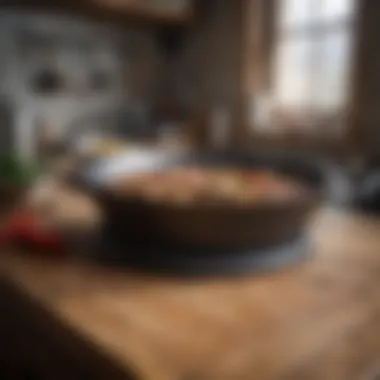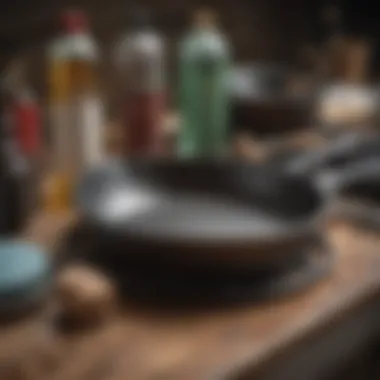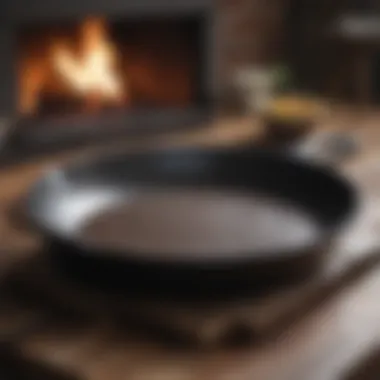Essential Post-Usage Care for Cast Iron Cookware


Intro
Key Takeaways
- Cleaning cast iron cookware requires specific techniques to avoid damage.
- Seasoning is essential for maintaining a smooth cooking surface and preventing rust.
- Storage practices can impact the cookware's performance over time.
- Neglecting these steps can compromise food quality and the skillet’s lifespan.
Cleaning Techniques
Cleaning cast iron cookware is paramount to its upkeep. Here are some strategies to consider:
- Avoid Soap: Traditional soap can strip away the seasoning. Instead, use hot water and a stiff brush to remove food residues.
- Dry Immediately: After cleaning, it's crucial to dry the skillet right away to prevent rust. A gentle heat on the stove can expedite this process.
- Use Salt: For tougher residues, a handful of coarse salt can act as an abrasive cleaner.
Seasoning Process
Seasoning your cast iron skillet enhances its non-stick surface.
- Preheat Oven: Heat your oven to a moderate temperature.
- Apply Oil: Use a thin coat of vegetable oil or flaxseed oil on the skillet’s interior. Be careful not to leave excess oil.
- Bake Upside Down: Place the skillet upside down in the oven. This allows any drips to fall off during the process.
- Cool Gradually: Let it cool in the oven, which helps bond the oil to the iron.
Storage Recommendations
Proper storage is often underestimated but equally important.
- Keep It Dry: Always ensure the skillet is thoroughly dry before storing it.
- Avoid Stacking: If stacking is necessary, place a paper towel between skillets to absorb moisture and prevent scratching.
"The care of cast iron is not a mere chore; it is an art that elevates culinary experiences."
End
Prelims to Cast Iron Care
Proper care of cast iron cookware is essential for its performance and longevity. The material's unique properties allow it to provide excellent heat retention, making it a favorite among both professionals and home cooks. Mismanagement can lead to rust, food sticking, or even degradation of the surface seasoning. Therefore, understanding how to care for cast iron is not just beneficial but necessary for its optimal use.
The significance of this topic extends to health considerations as well. Cast iron skillets can add valuable iron to a diet, but only when used correctly. This guide will take a deep dive into the best practices for maintaining cast iron cookware.
Historical Context of Cast Iron Cookware
Cast iron cookware has a rich history, tracing back to its origins in East Asia around the 5th century. The technology spread to Europe and later to America, where it became a staple item in kitchens. Significant innovation on the material saw cast iron pans evolve from simple frying pans to versatile tools capable of baking, sautéing, and even slow cooking.
Traditionally, these skillets were valued for their durability and ability to evenly distribute heat. They were passed down through generations, often gaining flavor and seasoning with each meal. This accumulation of family history is deeply intertwined with the act of cooking itself, emphasizing not only practicality but also the sentimental value of cast iron cookware.
Understanding the Material
Cast iron is an alloy of iron, carbon, and silicone, known for its remarkable heat distribution and retention properties. Unlike stainless steel or aluminum, cast iron can handle high temperatures, making it ideal for a variety of cooking methods.
The cookware comes with either an enameled or seasoned finish. Seasoned cast iron develops a natural non-stick surface from layers of oil baked into the iron, while enameled cast iron offers an easy-to-clean option, but can be less versatile in extreme heat. Both have their unique attributes and require specific care strategies.


Key considerations for understanding cast iron include:
- Heat Resistance: Can withstand very high temperatures without warping.
- Natural Non-Stick Properties: Evolve through proper seasoning, enhancing culinary experience.
- Health Benefits: Can contribute iron to food, beneficial for those with iron deficiency.
In summary, knowing the material allows for better maintenance practices, ensuring that cast iron cookware remains functional and effective for many years.
Post-Cooking Cleanup Procedures
Effective cleanup after using cast iron cookware is a vital part of maintaining its integrity and usability. Regardless of how sophisticated a dish may be, neglecting proper cleanup could result in diminished performance or even permanent damage to the cookware. Understanding the steps involved in the post-cooking cleaning procedure relates directly to both the lifespan of the pan and the quality of the food prepared in it. This section will break down two key elements: the timing of your cleanup and the removal of any food residue, while also addressing stubborn stains that may arise.
Immediate vs. Delayed Cleaning
After you finish cooking, you may face the choice of cleaning immediately or allowing the skillet to sit for a while. Immediate cleaning is often better because it prevents food from hardening. Food residue is easier to remove while still warm and moist. However, be cautious. A sudden temperature shift can lead to cracking. If you prefer delayed cleaning, let the skillet cool but do so safely; avoid sudden exposure to water. Leaving it too long, however, can make the task challenging.
Benefits of Immediate Cleaning:
- Easier removal of residues
- Prevents long-term staining
- Maintains the seasoning layer
Considerations for Delayed Cleaning:
- Requires less effort in the moment
- Has potential to exacerbate stains if left too long
Removing Food Residue
Removing food residue is critical for several reasons. First, it ensures that your cast iron skillet retains its seasoning and non-stick properties. Second, food particles can harbor bacteria if left unattended. When it comes to removing food residue, use a spatula made of wood or silicone to scrape the skillet. For tougher residues, hot water should be used in conjunction with a non-abrasive brush or sponge. Avoid soap, as it can negatively affect the skillet's seasoned surface. If you really need to use soap, make sure to re-season the skillet afterward.
Handling Stubborn Stains
Stubborn stains are often the result of careless cleaning or improper usage of the cast iron skillet. When dealing with these stains, do not resort to harsh chemicals or steel scouring pads. Instead, try a few different techniques. One approach is to create a paste from kosher salt and water. Apply this paste to the stained area, working it gently with a cloth. Alternatively, baking soda can be effective for lifting stains. Sprinkle it on and scrub lightly; this method can preserve the underlying seasoning as well.
"Once tarnished, a cast iron skillet has not lost its charm. With proper post-cooking care, even the most stubborn stains can often be addressed with simple household items."
In summary, the procedures employed in cleaning cast iron cookware immediately after cooking serve to maintain its usability and preserve food quality. Thus, whether you choose to clean immediately or delay, understanding how to effectively remove residue and handle stubborn stains will greatly assist in the longevity and functionality of your beloved cast iron skillet.
Drying and Seasoning Techniques
Caring for cast iron cookware encompasses more than just cleanup; drying and seasoning are crucial steps that enhance its durability and cooking performance. Neglecting these procedures can lead to rust accumulation, impaired cooking efficiency, and the degradation of the skillet's non-stick properties. This section articulates the significance of thorough drying, the proper application of oil for seasoning, and the effective heat treatment required for optimal seasoning.
Importance of Thorough Drying
After cleaning cast iron cookware, thorough drying is paramount. Cast iron is susceptible to moisture retention, which can promote rust and corrosion. To prevent this, it is essential to ensure that the skillet is completely dry before any storage.
- Moisture Control: Always towel dry your cookware immediately after washing. Heat the skillet on low for a few minutes to evaporate any remaining moisture.
- Long-term Longevity: A well-dried skillet will maintain its surface integrity and non-stick qualities, keeping it ready for your next culinary endeavor.
Neglect in this step can result in undesirable outcomes, such as flaking of seasoning and forgone seasoning processes. Taking time to ensure complete dryness creates a solid foundation for the subsequent seasoning steps.
Applying Oil for Seasoning


Once the skillet is thoroughly dried, applying oil is an essential step for seasoning. This practice fortifies the iron against moisture and enhances its non-stick properties.
- Choosing the Right Oil: Opt for oils with high smoke points such as flaxseed, grapeseed, or canola oil. These oils are ideal for developing a strong seasoning layer.
- Application Technique: Pour a small amount of oil onto the surface. Using a clean cloth or paper towel, spread the oil evenly, ensuring the entire surface is covered. Removing excess oil is vital to avoid stickiness.
This process forms a polymerized layer on the cast iron, increasing its resilience during cooking. It is this layer that fortifies the skillet against rust and significantly improves its usability.
Heat Treatment for Optimal Seasoning
Heat treatment follows the oil application and is essential for locking in the seasoning layer and enhancing its properties.
- Oven Method: Preheat your oven to a high temperature, around 400°F (200°C). Place the skillet upside-down on the oven rack, and lay a sheet of aluminum foil below to catch any drips. This method ensures the oil effectively binds to the iron.
- Duration: Allow the skillet to heat for about an hour. This process creates a hard, protective coating over the cast iron.
Proper heat treatment can double the lifespan of your cookware and dramatically improve its cooking capabilities.
Following these steps will not only preserve the skillet but also elevate the quality of the dishes prepared. By committing to these drying and seasoning techniques, users can ensure that their cast iron cookware remains a reliable companion in the kitchen for years to come.
Storage and Maintenance Tips
Proper storage and maintenance of cast iron cookware cannot be understated. This phase is crucial for preserving the skill and functionality of the skillet. If not done correctly, the potential for rust, damage, or loss of non-stick quality increases significantly. There are specific factors to consider when aiming for longevity and optimal performance in your cast iron. These include the environment in which the skillet is kept, moisture management, and the use of protective measures to prevent scratches and other damage.
Choosing the Right Storage Environment
When it comes to storing cast iron cookware, the environment plays a pivotal role. Ideally, cast iron should be kept in a cool, dry place away from direct sun exposure. High humidity can promote rusting, thus ruining your skillet over time. Condensation from heat and moisture, especially when the cookware is stacked with others, can accelerate problems. Therefore, it is advisable to keep cast iron skillets individually stored if possible. Investing in a cabinet or an area that maintains consistent temperature and low humidity will contribute greatly to its longevity.
Avoiding Moisture Buildup
Controlling moisture is a fundamental aspect of cast iron maintenance. After cleaning, ensure the skillet is thoroughly dried before storage. A brief period of heating on the stove can aid this process, evaporating residual moisture effectively. Storing the skillet with the lid off, or, if necessary, using a cotton towel to cover it will help in allowing air to circulate. Utilizing desiccants or moisture absorbers in the storage area may also be beneficial if one lives in a particularly humid environment. Avoid closing the skillet tightly with any lid or plastic wrap, as this will trap moisture.
Using Liners and Protective Layers
To prevent scratches and damage while in storage, utilizing liners or protective layers is advisable. These materials can minimize direct metal contact with other cookware. Options include dish towels or specially designed cookware protectors, which cushion the surface. Placing soft materials between stacked cookware aids in preventing wear and tear over time. This care helps maintain the seasoning layer, allowing for effective cooking performance whenever needed.
Preventative maintenance is far better than corrective action. Well-stored cast iron ensures a reliable cooking experience.
By addressing the right storage environment, managing moisture, and using protective layers, you ensure your cast iron cookware thrives in functionality and aesthetics.
Common Misconceptions about Cast Iron Skillets
Understanding the common misconceptions surrounding cast iron skillets is crucial for anyone engaged in their use and maintenance. Many of these beliefs can hinder the full potential that cast iron provides in culinary settings. Cast iron cookware, known for its durability and unique cooking properties, is often misunderstood, sometimes leading to improper care practices that can diminish its lifespan and performance.
Misconceptions not only affect how cast iron is perceived but also play a role in how effectively it can be utilized in the kitchen. This section aims to clarify misinformation, equipping readers with the knowledge necessary to maintain their cast iron skillets properly, enhancing both their cooking experience and the cookware’s effectiveness.
Debunking Myths on Cleaning Methods
One prevailing myth regarding cast iron cookware is the belief that it requires harsh cleaning methods to ensure hygiene. In reality, maintaining a cast iron skillet does not necessitate abrasive scrubbing or the use of soap in most cases. Many users fear that soap will strip the seasoning or cause rust. While it is indeed best to avoid soap for everyday cleaning, a gentle approach is often sufficient for most residues. It is beneficial to simply wipe the pan with a paper towel or cloth. Stubborn residue can often be removed with a paste of salt and water, which acts as a mild abrasive without damaging the seasoned surface.
Another myth suggests that cast iron must be completely dry before storage and cannot be submerged in water. While excess moisture should be avoided, a quick rinse with water followed by immediate drying on a stovetop can keep the skillet in good condition. The key point here is that while moisture must be minimized, this does not call for extreme measures that could lead to unnecessary wear on the cookware.


The Truth about Non-Stick Properties
There is often confusion regarding the non-stick capabilities of cast iron skillets. Some users believe that cast iron inherently holds non-stick properties upon purchase, while in reality, a well-seasoned cast iron skillet develops its non-stick quality over time. Seasoning, achieved through a process of oil application and heating, creates a polymerized layer on the cookware that enhances its non-stick performance. New cast iron products may not provide this benefit until they undergo proper seasoning.
Additionally, some assume that cast iron skillets will remain non-stick indefinitely. However, seasoning needs regular maintenance to sustain the non-stick characteristics. Factors such as cooking techniques, the types of food cooked, and cleaning practices contribute to the longevity of the non-stick surface. Users must be proactive about re-seasoning their skillets from time to time to maintain optimal performance.
Proper care and maintenance are essential for enjoying the benefits of cast iron cookware, ensuring it serves well in your kitchen for years to come.
By addressing these misconceptions, users can cultivate a more effective relationship with their cast iron skillets. Proper understanding allows for improved cleaning and seasoning habits that enhance both the durability of the cookware and the quality of the dishes prepared.
Health Considerations Related to Cooking with Cast Iron
When discussing cast iron cookware, health considerations emerge as a fundamental aspect of not only culinary preparation but also nutritional quality. Cast iron skillets are often lauded for their heat retention and even cooking properties, but they also contribute to our dietary iron intake. Understanding how these pans influence our health can lead to better cooking practices and improved nutritional outcomes.
Impact on Iron Intake
Cooking with cast iron can enhance dietary iron intake, which is essential for maintaining various bodily functions such as oxygen transport and energy metabolism. When food is prepared using cast iron, especially acidic foods like tomatoes or foods that are rich in moisture, there is a potential for the cookware to leach small amounts of iron into the food.
This is particularly beneficial for individuals at risk of iron deficiency, such as pregnant women, vegetarians, or people with certain medical conditions. Research indicates that the amount of iron released can vary based on factors such as the type of food, cooking time, the acidity of the ingredients, and the condition of the cookware itself.
However, it is crucial to balance this benefit with the understanding that excessive iron intake may lead to conditions like hemochromatosis, especially in individuals predisposed to iron overload. Consulting a healthcare provider or a nutritionist may provide tailored advice on the appropriate amount of dietary iron necessary for individual health.
Setting the Right Temperature for Cooking
Temperature regulation is also significant when cooking with cast iron. Heating the skillet too abruptly can cause it to warp or degrade its seasoning. A well-seasoned skillet not only improves the cooking surface but also affects how food interacts with the iron.
For optimal performance, it is advisable to:
- Preheat Gradually: Sudden temperature changes can damage both the cookware and the food being prepared. Start with medium heat and allow the cookware to warm evenly.
- Monitor Cooking Temperatures: Using medium-high heat is usually sufficient for most cooking needs. High temperatures can lead to over-seasoning loss, and may not be necessary for effective cooking.
- Be Mindful of Residual Heat: Cast iron retains heat well. Once the food is cooked, the leftover heat can continue to cook the food, which may lead to overcooking if not monitored.
"Adjusting heat levels appropriately can be as crucial as maintaining the health of the cookware itself."
By being aware of these health considerations related to cooking with cast iron, users can make informed choices that not only protect their cookware but also enhance their overall well-being through improved nutrition. Understanding the interplay between the material, cooking techniques, and dietary needs ensures that cast iron cookware continues to be a valuable tool in modern kitchens.
The End: The Value of Proper Care
Caring for cast iron cookware is not just a matter of preference; it is essential for both the longevity of the cookware and the quality of the food prepared with it. Understanding the value of proper care can transform an ordinary cooking experience into something exceptional. Proper maintenance ensures that the cookware remains non-stick and free from rust, which are crucial factors for efficient cooking and health.
Long-Term Benefits of Maintenance
The long-term benefits of proper maintenance of cast iron cookware are significant. Not only does consistent care enhance the cookware’s performance, but it also saves money over time. High-quality cast iron skillets can last for generations, and a well-maintained skillet can develop a natural non-stick layer, improving culinary results. Routine cleaning, seasoning, and proper storage can prevent the need for premature replacements, making your investment worthwhile.
Regular maintenance contributes to a consistently high level of cooking. Residue buildup can lead to uneven heating and flavors being retained in food. By ensuring thorough and regular cleaning, the integrity of flavors in dishes is preserved. This is especially relevant for health-conscious individuals who may be particular about ingredient purity.
Final Thoughts on Cast Iron Cookware
In summary, cast iron cookware stands out as a remarkable tool in any kitchen. Understanding the nuances of its care can set apart casual cooks from culinary enthusiasts. The lifeline of a cast iron skillet is rooted in knowledge and practice. By taking the time to properly care for these pans, users not only reap the benefits in taste and quality but are also contributing to sustainable cooking practices.
It is essential to take post-usage care seriously. Each step of the process—be it cleaning, drying, seasoning, or storing—plays a pivotal role in maintaining the effectiveness and safety of the cookware.
“The essence of good cooking lies in the tools you use and how well you care for them.”
Investing time in the proper techniques ensures that your cast iron cookware will serve you well for years to come. Engaging in these practices provides a better cooking experience and preserves the legacy of these timeless pieces.







